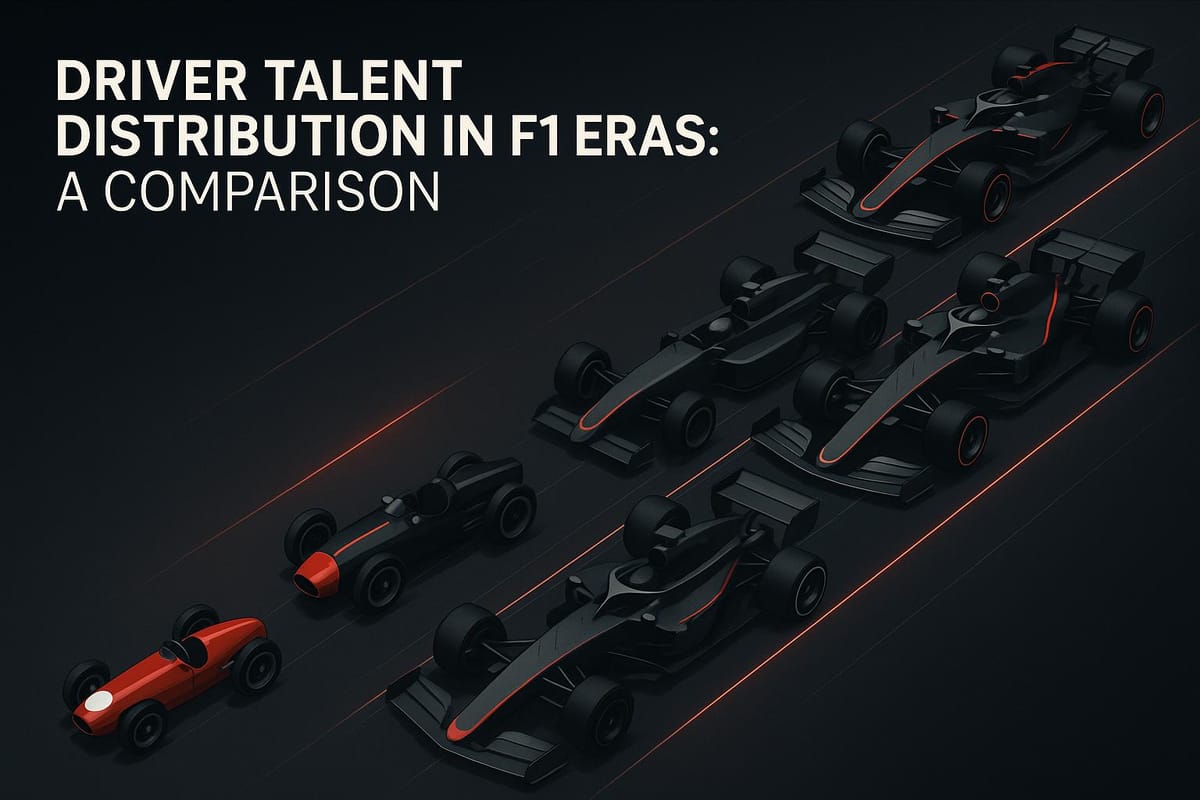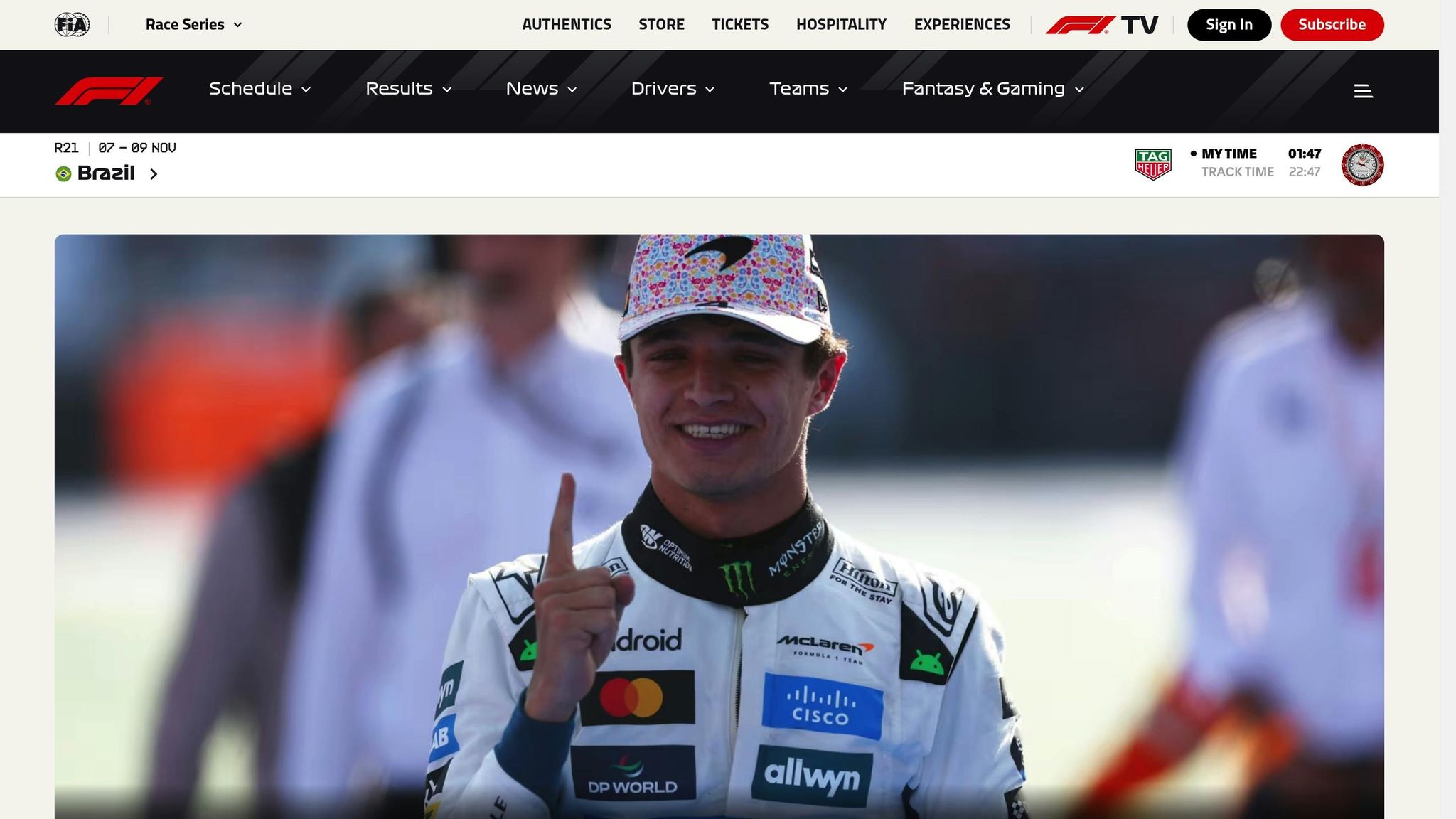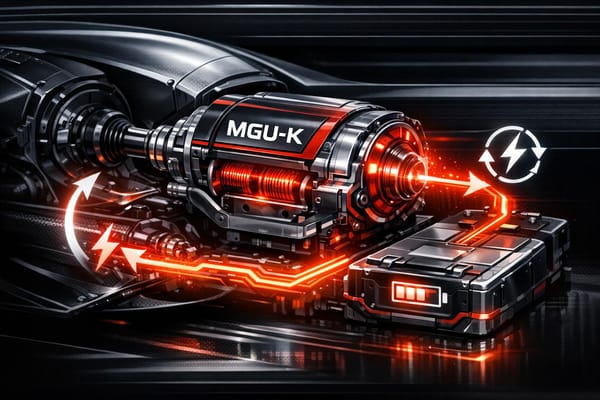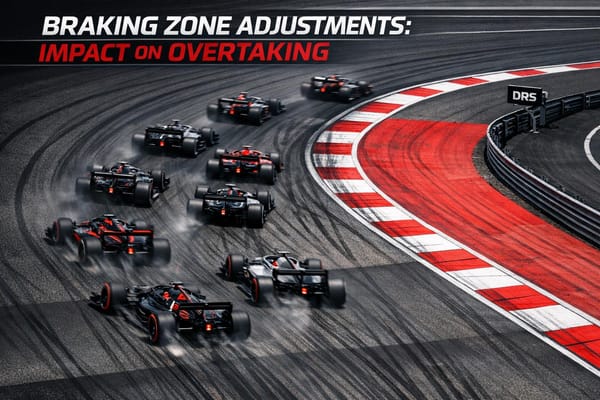Driver Talent Distribution in F1 Eras: A Comparison
Explore how driver talent distribution in Formula 1 has evolved through various eras, influencing competition and race outcomes.

Formula 1 has always been shaped by how driver talent is distributed across the grid. Some eras saw a few dominant drivers and predictable races, while others had a broader spread of skill, leading to more unpredictable outcomes. Here's a quick breakdown of how talent distribution evolved across four key periods:
- Early Years (1950s–1970s): Dominated by a small group of elite drivers like Juan Manuel Fangio. Mechanical failures and unpredictable conditions added variety, but podium spots were largely controlled by the same teams and drivers.
- Turbo Era (1980s): Turbocharged engines brought rapid technical changes. Top drivers like Ayrton Senna and Alain Prost concentrated in a few teams, but frequent mechanical failures created surprises.
- Schumacher Era (1990s–2000s): Michael Schumacher and Ferrari dominated, with reduced competition and predictable outcomes. Structural advantages like exclusive partnerships widened the gap between top teams and the rest.
- Hybrid Era (2014–present): Advanced hybrid engines and cost caps raised overall driver quality but concentrated success in teams like Mercedes and Red Bull. Stars like Lewis Hamilton and Max Verstappen dominated, leaving less room for mid-tier drivers to compete.
While driver skill has improved over time, the sport's structure often limits competition, favoring well-funded teams. Balancing talent across the grid remains a challenge for Formula 1.
History of Formula 1 Eras: Pick Your Own Path [FULL]

1. Early Years (1950s–1970s)
The first few decades of Formula One were marked by a small group of exceptional drivers who dominated the sport, shaping its competitive dynamics.
Talent Concentration
During the 1950s, Formula One saw a remarkable concentration of talent. Juan Manuel Fangio, for instance, achieved an extraordinary 46% win rate, securing 24 victories in just 52 starts. Drivers like Jim Clark and Jackie Stewart also stood out, showcasing not only their skill but also their ability to adapt to the unique challenges of the time.
The numbers speak volumes: between 1950 and 1979, only 16 drivers claimed the World Championship title. This dominance wasn’t purely about individual skill - it was also tied to the structure of the sport. Top drivers often aligned with well-funded teams, creating a cycle where success attracted more resources, further cementing their dominance.
Podium Patterns
Podium finishes during this era were largely predictable, with the same names and teams frequently appearing in the top spots. Fangio and Clark, for example, consistently found themselves on the podium, underscoring the significant performance gap between the elite and the rest of the field. While the grid often featured a large number of entrants, only a handful of drivers had the resources and talent to consistently contend for victories.
Unpredictable Outcomes
Despite the dominance of a few, race results were often unpredictable. Mechanical failures were common, even for the top teams, leaving outcomes uncertain and occasionally opening the door for mid-field drivers to achieve unexpected success. Weather also played a major role. Without advanced forecasting tools or specialized tire compounds, teams had to navigate races with limited information, adding another layer of unpredictability. Additionally, the lack of consistent safety and technical regulations contributed to the chaotic nature of the competition.
Structural Influences
The structure of the sport during this period heavily influenced how talent was distributed. Factory teams like Ferrari and Mercedes had the resources to attract the best drivers, while smaller privateer teams struggled to compete at the same level. Driver development was informal, relying on personal connections and reputation rather than structured junior programs. This approach created barriers for less-connected drivers, limiting their chances of breaking into the top tier.
Fangio’s five championships with four different teams highlight how fluid driver-team relationships were during this time. These dynamics not only concentrated talent at the top but also laid the groundwork for the evolving competitive structures that would define later eras.
2. Turbo Era (1980s)
The 1980s ushered in the Turbo Era, a time when turbocharged engines completely reshaped Formula One's competitive dynamics. This period introduced a level of technological complexity that not only changed how teams operated but also influenced the distribution of driver talent in ways unseen in earlier decades.
Talent Concentration
During this time, the most skilled drivers gravitated toward a handful of teams that excelled at mastering the new turbo technology. Teams like McLaren, Williams, and Ferrari became powerhouses, attracting legends such as Alain Prost, Ayrton Senna, and Nelson Piquet. Between 1984 and 1988, McLaren dominated the Constructors' Championships, taking home four titles and securing over 30 race wins with drivers like Prost and Senna leading the charge. Teams increasingly sought drivers who could provide detailed technical feedback and adapt quickly to the rapidly evolving cars.
Competitive Unpredictability
While a few teams held the lion’s share of success, the Turbo Era was anything but predictable. Turbo engines, though powerful, were notoriously unreliable, leading to frequent mechanical failures that often turned races on their heads. The constant stream of technical innovations meant that any advantage a team gained was often fleeting, with the competitive order shifting regularly.
The Role of Resources and Regulations
The 1980s also saw significant structural changes that influenced how driver talent was distributed. The soaring costs of developing turbo technology meant only the wealthiest teams could compete at the highest level. Partnerships with automotive giants like Honda, Renault, and BMW gave these teams access to cutting-edge engineering and resources. On top of that, evolving technical regulations - such as fuel limits and restrictions on boost pressure - added another layer of complexity, favoring teams with the resources to adapt. These factors concentrated top talent within well-funded teams, creating a pattern that would continue to evolve in later decades. This era laid the groundwork for even more refined talent strategies in the future.
3. Schumacher Era (1990s–2000s)
The Schumacher Era stands out as one of the most commanding periods in Formula One history, leaving a lasting impact on how driver talent and team strategies were distributed across the grid. Michael Schumacher's dominance with Ferrari created a dynamic where talent became concentrated, races grew increasingly predictable, and Ferrari's structural advantages reshaped the sport's competitive landscape. Let’s explore how Ferrari’s focused strategy, reduced podium variety, and systemic advantages defined this era.
Talent Concentration
The late 1990s and early 2000s saw a clear concentration of top-tier talent at the sport's pinnacle. When Schumacher joined Ferrari in 1996, the team adopted a new approach, assembling an elite technical team around him. Key figures like Ross Brawn as technical director and Rory Byrne as chief designer played pivotal roles in Ferrari’s dominance. Between 2000 and 2004, Schumacher clinched five consecutive championships, underscoring this strategy's success.
While other teams such as McLaren and Williams also had standout drivers like Mika Häkkinen, Kimi Räikkönen, and Jacques Villeneuve, the gap between these top teams and the rest of the field widened significantly. Promising talents like Fernando Alonso and Jenson Button were often held back by less competitive cars, which limited their ability to challenge for podiums consistently. This consolidation of talent at the very top contributed to fewer surprises on race day.
Podium Diversity
One of the defining characteristics of the Schumacher Era was the sharp decline in podium diversity. Ferrari’s technical and strategic dominance meant that Schumacher and his teammate Rubens Barrichello frequently claimed the top positions. Take 2002 as an example - Schumacher's relentless podium streak highlighted the extent of Ferrari's control over the competition. This dominance left little room for other drivers to break through, making the results feel repetitive for many fans.
Competitive Unpredictability
Ferrari’s overwhelming technical edge during this time often made race outcomes feel like a foregone conclusion. Championships were frequently decided well before the final races, and even the composition of the podium often seemed predictable. This predictability raised concerns about the long-term health of the sport, with many questioning whether Formula One was losing its edge as a competitive spectacle.
Structural Advantages
Ferrari’s success during this era wasn’t just about driver skill or engineering brilliance - it was also reinforced by structural factors. With a massive budget and strategic partnerships, such as their exclusive relationship with Bridgestone, Ferrari secured a significant advantage over rivals. At the same time, less formalized driver development programs and stricter superlicense requirements made it harder for emerging talent to break into the sport. These factors combined with evolving technical regulations to cement Ferrari’s dominance.
The imbalance eventually led to calls for sweeping regulatory changes, such as budget caps and stricter technical rules, aimed at leveling the playing field. The goal was to shift the focus back to driver skill rather than financial and structural advantages, ensuring a more competitive future for Formula One.
4. Hybrid Era (2014–present)
The Hybrid Era, starting in 2014, brought in hybrid power units that reshaped the competitive landscape of Formula 1. Just like in earlier periods, advancements in technology and the unequal distribution of resources have continued to influence where top driver talent ends up.
Talent Concentration
Between 2014 and 2020, Mercedes dominated the grid with Lewis Hamilton and Nico Rosberg, securing eight straight Constructors' Championships. Hamilton alone claimed six Drivers' Championships during this period. Since 2021, Red Bull has taken over as the dominant force, with Max Verstappen winning four consecutive titles from 2021 to 2024. This intense focus on elite talent in top teams has left limited room for other skilled drivers to shine. Talents like Charles Leclerc at Ferrari, Lando Norris at McLaren, and George Russell (prior to his move to Mercedes) have struggled to fully showcase their potential due to their teams' technical limitations.
Podium Diversity
In 2021, the dominance of Hamilton and Verstappen was undeniable - they won 18 of the season’s 22 races. While other drivers have occasionally disrupted this pattern, such moments remain rare. For instance, Sergio Pérez managed race wins before joining Red Bull, and Pierre Gasly’s victory at the 2020 Italian Grand Prix was a standout exception. Still, podium finishes have largely been concentrated among a few drivers, reflecting a familiar trend from previous eras.
Competitive Unpredictability
The Hybrid Era has seen race results become increasingly predictable. The technical and financial advantages held by top teams have widened the performance gap across the grid. Championships are often decided well before the final races of the season. Even with the introduction of cost caps in 2021 and regulatory changes aimed at leveling the playing field, dominance has simply shifted from one team to another rather than being eliminated. These patterns underscore the challenges of creating true unpredictability in the sport.
Impact of Structural Systems
The cost cap, implemented in 2021, was designed to address financial disparities between teams. However, its effects have been slow to materialize and have yet to significantly disrupt the competitive hierarchy. Meanwhile, the technical complexity and high costs associated with hybrid power units have cemented the advantages of well-funded teams. On top of that, stricter superlicense requirements have raised the overall skill level of drivers but also narrowed the pathways for new talent. Today, 67% of drivers boast performance ratings above 6 points per race, reflecting a higher baseline of talent.
The Hybrid Era encapsulates a paradox: driver quality across the board has never been higher, yet structural barriers have concentrated success within a handful of dominant teams. This has led to spectacular individual achievements but fewer opportunities for broader competition. This trend mirrors historical patterns and highlights the ongoing struggle to achieve a more balanced competitive environment in Formula 1.
Pros and Cons
Each era of Formula 1 brings its own set of strengths and challenges when it comes to how talent is distributed. The table below breaks down these differences across key periods in the sport's history.
| Era | Talent Concentration | Podium Diversity | Unpredictability | Key Advantage | Main Drawback |
|---|---|---|---|---|---|
| Early Years (1950s–1970s) | High | Low | Low | Legendary rivalries | Few breakthrough opportunities |
| Turbo Era (1980s) | Moderate | High | Moderate-High | Technical innovation balanced competition | Reliability issues overshadowed driver skill |
| Schumacher Era (1990s–2000s) | Very High | Low | Low | Driver-team synergy at its peak | Predictability reduced excitement |
| Hybrid Era (2014–present) | High | Moderate | Moderate | Unparalleled driver quality | Financial barriers limit competition |
The Early Years (1950s–1970s) were defined by iconic rivalries and legendary drivers like Juan Manuel Fangio and Jim Clark. These figures carved their places in racing history, often dominating the competition. However, this era lacked diversity on the podium. Only a handful of drivers and teams consistently claimed victories, making it tough for new talent to break into the spotlight. For fans, this predictability occasionally dulled the excitement of race outcomes.
During the Turbo Era (1980s), Formula 1 saw a surge in technical innovation, which brought more variety to podium finishes. Teams like McLaren, under Ron Dennis, demonstrated how multiple star drivers could coexist and thrive. This period also introduced a level of unpredictability, as technical advancements shook up the grid. However, reliability issues often interfered, sometimes skewing results and overshadowing raw driver skill.
The Schumacher Era (1990s–2000s) showcased the unmatched synergy between drivers and teams, epitomized by Michael Schumacher and Ferrari's dominance. They shattered records and set new benchmarks for performance. Yet, this era also highlighted the downside of concentrated talent. With fewer drivers and teams able to challenge for wins, races became highly predictable, which could alienate fans looking for competitive variety and surprises.
In the Hybrid Era (2014–present), Formula 1 has reached new heights in terms of driver talent. Stars like Lewis Hamilton, with 105 wins, and Max Verstappen have dominated the scene, while younger drivers like George Russell and Lando Norris have occasionally broken through. However, the technical complexity and financial demands of hybrid power units have created significant barriers. Well-funded teams hold a clear edge, leaving less-resourced teams struggling to compete on equal footing.
Throughout F1 history, there's been a constant trade-off. High talent concentration often leads to extraordinary individual achievements but reduces the depth of competition. On the other hand, periods with more evenly spread talent usually bring unpredictable and thrilling races, though they may lack the dominant figures who captivate global audiences. The ongoing challenge for Formula 1 is to strike a balance: maintaining the sport's elite standards while ensuring more drivers and teams have a genuine shot at success.
Conclusion
The distribution of driver talent in Formula 1 has undergone a striking transformation over the decades. Back in the 1950s and 1960s, the sport relied on a much smaller pool of elite drivers. Fast forward to today, and the grid is packed with talent, thanks to major shifts in how drivers are scouted, nurtured, and prepared for the pinnacle of motorsport.
The numbers tell the story vividly. In the 2010s, 67% of drivers averaged over six points per race. Compare that to the earlier days, when legends like Juan Manuel Fangio stood out largely because the field was far less competitive. Modern systems for talent development, such as driver academies and data-driven scouting, have created an environment where young stars like Max Verstappen and Charles Leclerc can rise to prominence faster than ever. These programs not only accelerate skill development but also ensure drivers are race-ready earlier in their careers.
However, this increasingly even distribution of talent introduces new challenges. While the overall quality of drivers has improved, success in Formula 1 still heavily depends on the car. The average driver salary of $10 million represents just 7% of a team’s total budget, highlighting the undeniable role of superior machinery in securing championship victories.
Looking ahead, several trends could reshape how talent impacts the sport. Cost caps and tighter technical regulations aim to level the playing field, potentially allowing more drivers to contend for wins, regardless of their team’s financial muscle. At the same time, global scouting and advanced development programs continue to expand the talent pool geographically. Yet, these advancements come with their own complexities, including how to manage and balance this growing pool of talent with the sport's financial and technical disparities.
Formula 1 today is a blend of extraordinary driver skill and the necessity for top-tier equipment. While the baseline talent level rises due to stricter entry standards, such as superlicense requirements, the gap between top teams and midfield teams still limits the potential for a truly even playing field. This makes it clear that while the sport has progressed significantly, the challenge lies in ensuring that the depth of talent can translate into broader competitiveness across the grid.
FAQs
How have F1 regulation changes shaped driver talent distribution over the years?
Changes in F1 regulations have significantly influenced how driver talent is evaluated and utilized across different eras. Adjustments to rules around aerodynamics, tires, and engine performance have shaped team strategies, car designs, and the skill sets drivers need to succeed.
For instance, periods of advanced technology often benefited drivers with strong technical feedback skills, as their input was crucial to optimizing complex systems. On the other hand, eras with simpler cars placed a greater emphasis on raw driving ability. These shifts not only altered how talent was assessed but also affected its distribution among teams, sometimes leading to dominant periods for certain teams or fostering more intense competition across the grid.
Why do some Formula One teams consistently attract the best drivers, even with efforts to create a more balanced competition?
Certain Formula One teams have a knack for consistently pulling in the sport's top drivers. Why? It often boils down to a mix of success, cutting-edge technology, and hefty financial backing. For drivers, joining a team with a proven championship record and the ability to deliver competitive cars season after season is a no-brainer.
But it’s not just about the cars. These teams also shine because of their strong leadership and smart strategic calls, both on and off the track. Add in major sponsorship deals and a culture that supports and develops talent, and it’s clear why these teams are magnets for elite drivers. Their history of success and commitment to excellence make them the ultimate destination for those aiming to compete at the highest level.
How do technology and financial investments influence competition in modern Formula 1?
In Formula 1, technology and financial investments are at the heart of the competition. Teams are always striving to innovate, especially in areas like aerodynamics, engine performance, and materials science. These advancements can be the difference between standing on the podium or falling behind.
Money plays an equally important part. A team's budget dictates how much they can pour into cutting-edge technology, hire top-tier engineers, and build advanced facilities. Teams with larger budgets often have the luxury of conducting more extensive testing and fine-tuning their designs, which can translate into better results on race day.
That said, recent cost cap regulations have been introduced to curb excessive spending. These rules aim to create a more balanced competition by ensuring that success isn’t solely determined by the size of a team’s wallet. It’s a move designed to keep the grid competitive and give smaller teams a fighting chance.




